Panasonic showed four new projectors at ISE, plus they introduced a fifth projector not shown on their stand. In addition, they introduced the new EQ1 series of LCDs that range in size from 43” to 86” and targeted signage and other professional applications.
Panasonic PT-RQ22K projector. (Credit: Panasonic)
The new PT-RQ22K is a 3-chip 0.9” DLP projector with 21,000 lumen output. The system uses what Panasonic calls “Quad Pixel Drive,” i.e. pixel shift, to produce 4K+ (5120 x 3200) resolution from the native 2560 x 1600 resolution of the DLP chips. The Solid Shine laser light source is said to provide 20,000 hours of operation. The optical system is hermetically sealed and dust-resistant plus the heat-pipe-based cooling system is filterless, all to minimize the need for maintenance.
The system achieves 20,000:1 dynamic contrast by modulating the light output of the light source. The projector can use the same lenses as 1-chip DLP projectors from Panasonic. Lens shift is dependent on the lens used but can be up to +50% to -16% vertically and +30% to -10% horizontally. Since the projector has free 360° installation, if you need -50% vertically or -30% horizontally, just install the projector upside down.
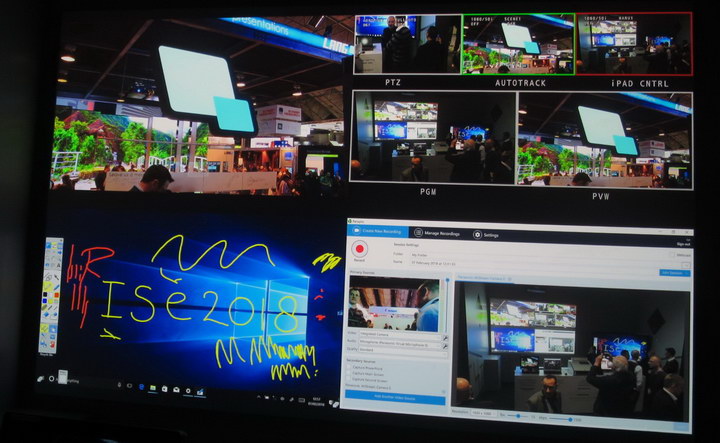 Image produced by the RQ22K when showing four separate 1080P images (Credit: M. Brennesholtz)
Image produced by the RQ22K when showing four separate 1080P images (Credit: M. Brennesholtz)
The standard video inputs of the RQ22K projector are 4 x 3G-SDI. In addition, the projector has two slots for Slot NX plug-in cards. Panasonic says that one of the available cards is a 12G-SDI card. The projector electronics feature 4K BT2020 color space emulation and support HDR standards for accurate handling of next-generation video signals. With internal geometry correction and other special features, these projectors are said to be particularly suited for projection mapping. The RQ22K projector will be available starting in August.
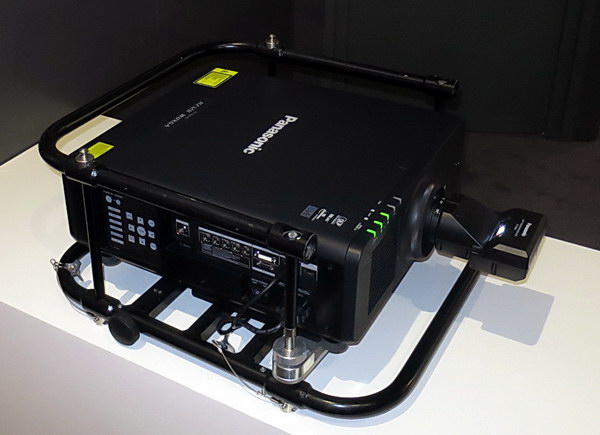 Panasonic RZ120 with a short-throw lens and a rigging frame at ISE. It is producing an image on a screen out of the photo to the left. (Credit: M. Brennesholtz)
Panasonic RZ120 with a short-throw lens and a rigging frame at ISE. It is producing an image on a screen out of the photo to the left. (Credit: M. Brennesholtz)
The new PT-RZ120 and PT-RZ870 projectors fill in the range of the existing RZ series of projectors. These projectors are all single chip DLP systems with “Solid Shine” laser-phosphor light sources. The RZ120 and the RZ870 both have WUXGA (1920 x 1200) resolution and 0.67” DLP imagers with 10:000:1 dynamic contrast. The RZ120 has 12,000 lumens output and the RZ870 has 8500 lumens. (Note: do not mistake the new PT-RZ120 for the existing PT-RZ12, which also has 12,000 lumens but is a 3-chip DLP projector.)
Existing members of the single chip RZ family include the PT-RZ970 with 9200 lumens, the PT-RZ660 with 6200 lumens and the PT-RZ575 with 5200 lumens output. These projectors are also all single chip DLP projectors with WUXGA resolution. The PT-RZ120 and PT-RZ870 projectors will be available starting in November.
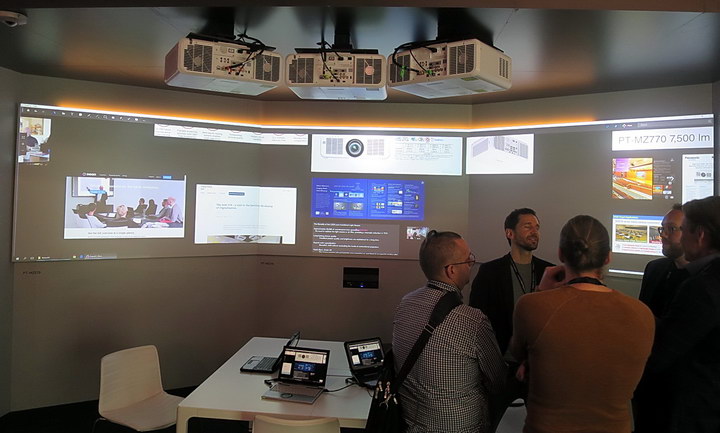 The projector on the right is the new PT-MZ770. The center and left projectors are is the existing MZ670 and MZ570 respectively. (Credit: M. Brennesholtz)
The projector on the right is the new PT-MZ770. The center and left projectors are is the existing MZ670 and MZ570 respectively. (Credit: M. Brennesholtz)
Panasonic also introduced the new PT-MZ770 3LCD projector series. This comes in two versions, both with 7500 lumens output: WUXGA (1920 x 1200) and WXGA (1280 x 800). Both have Solid Shine laser-phosphor light sources with 20,000 hour life. While the projectors have a filter, like most 3LCD projectors, the filter also has an expected life of 20,000 hours. The projectors are said to have 3,000,000:1 contrast with dynamic contrast turned on. The more important static contrast numbers are not given.
Five different zoom lenses and one fixed focus lens are available for the projector. Lens offset depends on lens chosen but can be up to ±67% vertically and ±35% horizontally. The projector is intended for mid-sized business and educational venues. The projector will be available starting in July.
The PT-VW360 series of 3LCD projectors was formally introduced at ISE but not shown on the Panasonic stand. The two projectors in the series have WXGA (1280 x 800) with 4,000 lumens and XGA (1024 x 768) with 4,500 lumens, otherwise they are identical. They use a 240W mercury lamp with 5000 hours of life in the normal mode and 7000 hours in the Eco mode. The projectors are designed to be portable and each weights 3.3Kg (7.3 pounds). These projectors are expected to be available in May.
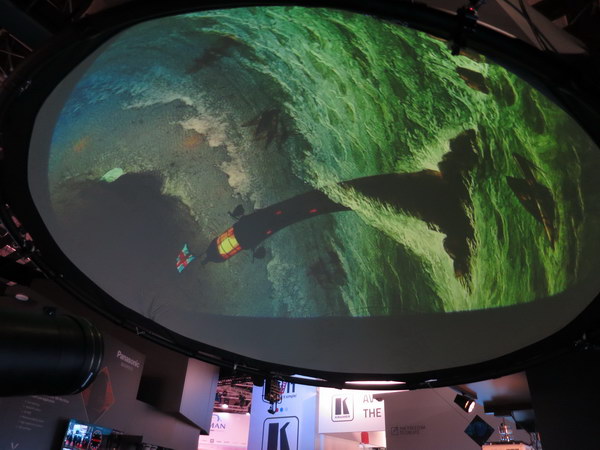 Panasonic dome projection lens, the ET-D3LEF70, can mostly fill a small dome from a single projector. (Credit: M. Brennesholtz)
Panasonic dome projection lens, the ET-D3LEF70, can mostly fill a small dome from a single projector. (Credit: M. Brennesholtz)
Panasonic was also showing a new dome projection lens, the ET-D3LEF70 for its installation DLP projectors. This lens allows a single projector to pretty much fill a dome display when projecting from one side. In the image, the end of the relatively long lens is just visible on the lower left side.
 Panasonic EQ1 Series of displays at ISE. (Image:Meko)
Panasonic EQ1 Series of displays at ISE. (Image:Meko)
Panasonic was also showing its new EQ1 series of LCD displays. Displays in the series range from 43” to 86”. All members of the series are UHD (3840 x 2160) and have 350 cd/m² brightness. The Panasonic representative at ISE said some of the units would be as bright as 450 cd/m², but that wss not indicated in the printed specs. The 86” and the 75” units both use IPS and have 1400:1 and 1200:1 contrast respectively. The 55”, 50” and 43” members of the series all use VA and have a contrast of 4000:1.
The EQ1 series displays all have built-in USB media players and multiple displays can be daisy-chained via the LAN for showing the same content on multiple EQ1 series displays. They support 4K60 video via 2 x HDMI ports with HDCP 2.2 and CEC capability. They also have DVI-D, PC In and Video In. they can be controlled via RS-232 or LAN using either AMX or Crestron systems. The pair of built in speakers are 10W/speaker.
I was told by the Panasonic representative that these displays are considered entry-level. The will be available starting in the autumn of 2018, with the exact date depending on the model. The displays are intended for applications such as retail, public spaces, showrooms, meeting rooms and classrooms.
The company had a range of demonstrations of software that supports the OpenPort SoC architecture that Panasonic has in its digital signage monitors. It was also demonstrating video and audio being transmitted over IP networks and being decoded by the integrated SoC. The content uses RGB Spectrum Zio technology.
LightRay Develops
Panasonic has been developing its ‘data via LED modulation’ system for some time under the LightRay name and the technology was first introduced in LCD backlights and spotlights. This allows users to get data on mobile devices – a big feature for travel or museums which can then support many languages or versions of data. Museums do not need to worry about charging and maintaining devices themselves. The company is now extending the support of LinkRay into projectors and was showing a 3LCD projector using the concept.and Enrique Robledo, who showed us around, said that the technology would also be introduced in DLP-based projectors later.
The firm is very motivated around solutions these days and museums and event locations are a target vertical, so the company has also worked with makers of museum showcases to ensure support. It seems that there are only a handful of companies that can meet the security and other requirements of museums and Panasonic has worked with a leading supplier. That means that Panasonic can now support flat and projection displays, lighting and showcases.
The company has also developed a Linkray control panel that can be used to link to meeting room displays. This modulates an LED lamp that can be used to illuminate details of the system and was being demonstrated with dual UltraH TH-75BQE1 interactive displays.
The range of LCDs that support LinkRay has been increased with 70″ and 80″ FullHD 24/7 displays with 700 cd/m² of output and 5,000:1 contrast.
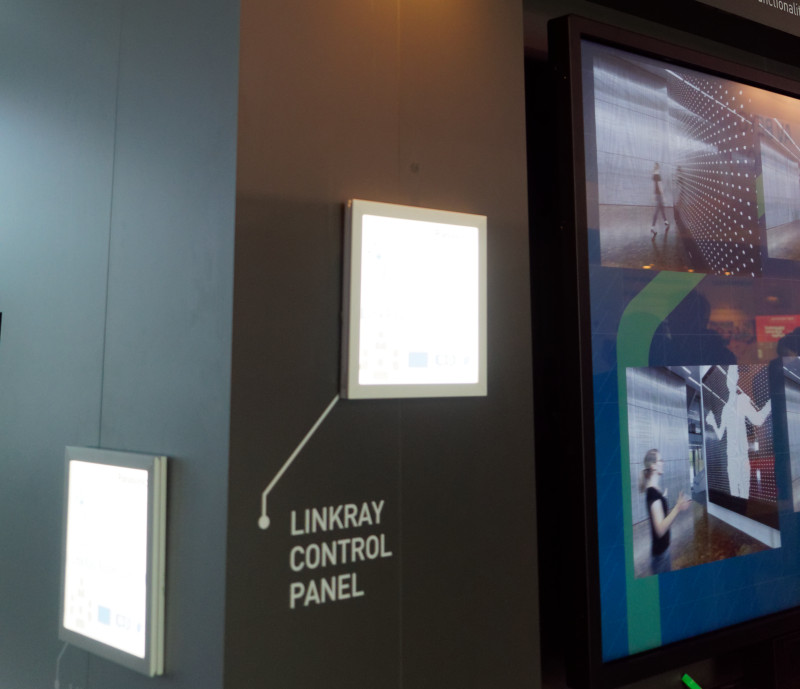 Panasonic showed a LinkRay Control Panel connecting to a meeting. Image:Meko
Panasonic showed a LinkRay Control Panel connecting to a meeting. Image:Meko
Interaction Important
The company was showing its display integrated into systems including NFC shelf technology for dynamic signage in retail and was also show large interactive displays using Baanto’s ShadowSense technology.
The final demonstration we looked at was the latest version of the Dynamic Projection Institute mirror head which has now been developed to work with both single and three chip DLP systems, extending the range of applications. It was previously only available on three chip systems.
 DPI’s Mirror Head now supports single chip DLP projectors. Image:Meko
DPI’s Mirror Head now supports single chip DLP projectors. Image:Meko
–Matthew Brennesholtz & Bob Raikes

